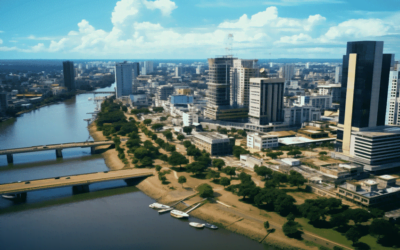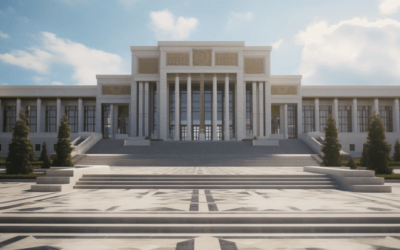Hey there, fellow drone enthusiasts and curious readers! If you’ve ever found yourself gazing up at the skies and wondered about the drone regulations in Tajikistan, you’re in the right place. Perhaps you’re planning to visit this stunning Central Asian country or already live there, and you’re eager to explore the skies with your trusty drone.
Well, let me tell you, I’ve been right where you are, and I understand the itch to get those rotors spinning above the breathtaking Tajik landscapes.
So, you might be thinking, what makes me the go-to person for the latest scoop on Tajikistan’s drone laws? The answer lies in the countless hours of research I’ve devoted to unraveling the drone regulations in this beautiful country.
I’ve pored over official documents, spoken with local authorities, and scoured the web to compile the most up-to-date and comprehensive information about Tajikistan’s drone laws. Trust me; I’ve been through the intricacies of the rules and guidelines so you won’t have to.
If you’re eager to soar into the Tajik skies with your drone and want to ensure you do it the right way, then you’ve come to the right place.
In the following article, I’m going to break down everything you need to know about Tajikistan’s drone laws, from registration and flight restrictions to safety measures and even how to handle your drone for commercial purposes.
Your search for clarity and guidance regarding Tajikistan’s drone regulations ends here.
So, sit back, relax, and read on, because by the time you’re done, you’ll have all the answers you seek to navigate the Tajikistan skies with confidence and legality.
Registration and Categorization

Let’s delve into the heart of the matter, shall we? In Tajikistan, like in many places around the world, drones aren’t all treated the same. The way these unmanned birds are classified and registered plays a crucial role in determining how you can fly them. It’s a world of its own, and I’m here to unravel it for you.
categorization of drones based on weight and purpose
You see, when it comes to drones in Tajikistan, they’re not all created equal. The classification system here primarily depends on two key factors: weight and purpose.
Weight-wise, drones are usually categorized into different classes, from tiny featherweights to the big birds with heft.
The purpose also makes a big difference – whether you’re flying for fun or for profit.
Now, I know you might wonder why this matters. Well, it’s because the rules, restrictions, and registration requirements can differ based on these categories.
Lighter drones intended for recreational use might have a simpler path, while heavier ones or those used for commercial ventures could have more hoops to jump through.
So, the next time you pick up your drone, take a moment to consider where it falls in the grand scheme of categorization. It might just determine your next flying adventure.
Registration requirements for drones in Tajikistan
Droning regulations is never the most thrilling conversation, but when you’re a drone enthusiast in Tajikistan, it’s essential to know the ropes. Registering your drone here is a must, regardless of whether you’re flying it for personal enjoyment or business purposes.
The authorities need to keep tabs on who’s operating these aerial machines in their skies.
The registration process is typically straightforward, and it helps to ensure safety and accountability. You’ll need to provide some basic information about yourself and your drone, such as its make and model, serial number, and, of course, your contact details.
Don’t worry; it’s not as intimidating as it might sound. In fact, it’s a simple step to keep the drone skies orderly and secure.
Recreational and commercial drone operation
Now, let’s talk about the fine line between flying for fun and flying for a living. In Tajikistan, as in many places, there’s a distinct difference in how drones are regulated based on your intentions.
If you’re out there just enjoying the thrill of flying your drone with no financial gain in mind, that’s considered recreational use. It’s like having your own little bird in the sky, capturing stunning views or just having a blast.
But if you’re looking to make a profit with your drone, whether it’s aerial photography, surveying, or any other commercial endeavor, there are additional steps and requirements. Commercial drone operators often need special permits and licenses to ensure that they meet the country’s safety and legal standards.
It’s a bit more paperwork, but it’s all part of the process when you’re taking your drone adventures to the next level. So, whether you’re a weekend flier or a professional pilot, there’s a place for you in the Tajikistan skies.
Also Read: Drone Laws in Taiwan 2024
No-Fly Zones

Now, let’s explore the territory where even the most adventurous drone pilots must tread carefully – the no-fly zones in Tajikistan. Understanding where your drone can’t go is just as vital as knowing where it can.
Restricted areas, including airports, military installations, and sensitive locations
Tajikistan’s no-fly zones are much like a well-guarded treasure map. The “X” marks include critical areas such as airports, military installations, government buildings, and other sensitive locations.
These places are, understandably, off-limits for drone flights. For instance, flying your drone near an airport isn’t just a legal matter – it’s a safety concern. The last thing you’d want is an unexpected encounter with a passenger plane.
Beyond airports, military installations, and government buildings, it’s wise to exercise common sense. Any area with sensitive infrastructure, crowded public spaces, or gatherings should be approached with caution.
Respecting these boundaries not only keeps you out of legal trouble but also ensures that your drone adventures are safe and considerate of others.
Consequences of flying in no-fly zones
So, what happens if you decide to take your drone where it shouldn’t be? Flying your drone in no-fly zones can lead to some unwelcome consequences.
At the very least, you might attract the attention of local authorities or security personnel who’ll kindly ask you to land your drone. But if you persist, it could escalate to legal trouble, including fines or even the confiscation of your beloved flying companion.
More importantly, remember that the consequences extend beyond legal matters. Flying in restricted areas can pose serious risks to public safety and national security. It’s not just about rules and regulations; it’s about being a responsible drone pilot and ensuring that your hobby doesn’t endanger others.
Tools and resources for checking no-fly zones in Tajikistan
Now, how can you stay on the right side of the law and avoid these no-fly zones? Fortunately, technology has your back. There are various tools and resources available to help you identify these restricted areas.
Some drone manufacturers provide software that can automatically prevent your drone from taking off in no-fly zones. Additionally, you can use apps and websites that offer real-time maps showing where it’s safe to fly.
Checking these resources before every flight should become a standard part of your pre-flight routine. It’s not only a legal requirement but also a responsible action to ensure you’re flying your drone safely and without any unwanted run-ins with the authorities. So, make these tools your best friends when it comes to navigating the Tajikistan skies.
Also Read: Syria Drone Laws 2023 2024
Flight Rules and Best Practices

Now, it’s time to get to the nitty-gritty of drone flight rules and best practices in Tajikistan. Understanding how to take to the skies responsibly is crucial for an enjoyable and safe drone experience.
Guidelines for Safe Drone Operation
you’re on a hill, drone controller in hand, ready to explore the Tajikistan landscape from above. Before you hit that takeoff button, there are a few essential guidelines to keep in mind.
Maintaining visual line of sight
One of the golden rules of drone operation is to maintain a visual line of sight with your drone. This means keeping it in your line of sight at all times while it’s up in the air. Why is this important? Well, it’s all about safety. By having your drone within your sight, you can quickly react to any obstacles or potential issues. It’s a simple yet effective way to ensure your flight is under control and doesn’t stray into unexpected territories.
Altitude limits for drone flights
The Tajikistan skies might seem endless, but there are limits to how high you can go. In most cases, drone regulations set altitude limits to ensure the safety of manned aircraft. These limits can vary based on your location and the specific rules in place, so it’s crucial to check the local regulations.
Staying within these limits not only ensures your drone doesn’t interfere with other airspace users but also helps you avoid any potential legal complications.
Prohibitions on flying over people or gatherings
When it comes to flying your drone over people or gatherings, the rule is simple – don’t. This isn’t just about respecting personal space; it’s about safety. Flying a drone over people can lead to accidents, injuries, and privacy concerns. So, always steer clear of populated areas, crowded events, and gatherings when you’re in flight mode.
Tips for responsible and safe drone use
Now, let’s talk about some general tips for responsible and safe drone use. First and foremost, always follow the user manual and guidelines provided by your drone manufacturer. These are your trusty companions in ensuring safe and optimal drone operation.
Secondly, be considerate of your surroundings. Not everyone might share your enthusiasm for drones, so it’s essential to respect privacy and local laws.
Avoid flying over private property without permission and refrain from capturing images or video in areas where people have a reasonable expectation of privacy.
Lastly, stay informed and keep learning. Drone technology evolves rapidly, and so do the regulations. By staying up-to-date and continuing to educate yourself, you’re ensuring that your drone adventures in Tajikistan remain not only thrilling but safe and respectful of the rules.
Also Read: Drone Laws in Switzerland 2024
Liability Insurance

Now, let’s talk about a crucial aspect of drone operation that often flies under the radar – liability insurance. Whether you’re a hobbyist or a commercial operator, understanding the role of insurance in your drone adventures is vital.
Requirement for liability insurance, particularly for commercial drone operators
Liability insurance for drone operators in Tajikistan isn’t just a nicety; it’s a necessity, especially if you’re flying your drone for commercial purposes. Commercial drone operators often handle more significant risks, as their flights may involve capturing images, conducting surveys, or providing services.
Liability insurance steps in as a safety net, covering potential damages or injuries that might occur during drone operations.
The requirement for liability insurance is often tied to the permits and licenses you might need as a commercial operator. It’s a way to ensure that you’re financially responsible for any potential accidents or mishaps during your drone missions.
It might sound like a daunting extra step, but it’s all part of being a responsible drone pilot in Tajikistan.
Information on where to obtain insurance coverage
So, where do you go to obtain this crucial liability insurance? Well, the good news is that there are insurance providers who specialize in drone coverage. These companies offer insurance packages tailored to drone operators, whether they’re flying for business or pleasure.
When seeking insurance coverage, it’s essential to do your homework. Check the terms, coverage limits, and costs offered by different insurance providers.
Some providers even offer on-demand insurance, allowing you to purchase coverage for specific flights. It’s all about finding the right fit for your needs and ensuring that you’re adequately covered while complying with Tajikistan’s drone laws.
Whether you’re a hobbyist or a professional drone pilot, having liability insurance is a wise move. It provides that extra layer of security and peace of mind, allowing you to enjoy your flights without the looming fear of unforeseen liabilities. So, when you’re ready to take off on your next drone adventure in Tajikistan, consider making liability insurance a part of your pre-flight checklist.
Also Read: Drone Laws in Sweden 2024
Remote Identification

Now, let’s touch upon an exciting development in the world of drone regulations – remote identification. It’s a concept that holds great promise for tracking and accountability in the drone community.
Emerging regulations related to remote identification of drones
Remote identification is a relatively new addition to drone regulations, and it’s gaining traction not only in Tajikistan but around the globe.
The idea behind it is pretty straightforward. Drones will be equipped with technology that broadcasts identifying information to authorities or other parties when in operation. This is like giving each drone a digital license plate.
Emerging regulations in Tajikistan and other countries aim to ensure that all drones, particularly those used for commercial purposes, are equipped with this remote identification technology. It’s a step toward enhancing accountability and security in the skies.
With remote ID, it becomes easier to identify drone operators, and their drones, and monitor their activities.
Importance of remote ID for tracking and accountability
Why does remote identification matter? Well, it’s all about accountability and safety. When authorities can quickly identify a drone and its operator, it becomes easier to manage the airspace, enforce regulations, and respond to any incidents or accidents.
It’s like having an air traffic control system for drones, ensuring that everyone is on the same page when it comes to who is flying where and for what purpose.
From a safety perspective, remote ID can be a game-changer. It allows for more effective management of airspace, reducing the risk of mid-air collisions and other accidents. This technology also aids in addressing security concerns, as it becomes easier to track and respond to drones flying in restricted or sensitive areas.
While the adoption of remote identification might introduce new responsibilities for drone operators, it ultimately contributes to safer and more organized skies in Tajikistan and beyond. It’s a step toward a future where drones can coexist harmoniously with other forms of aviation and enhance their role in various industries.
Also Read: Drone Laws in Suriname 2024
Recent and Upcoming Changes

In the ever-evolving world of drones, it’s essential to stay informed about the latest developments in Tajikistan’s drone laws. Whether it’s recent updates or upcoming changes, here’s what you need to know.
Recent changes to Tajikistan’s drone laws
Change is the only constant, they say, and it applies to drone regulations too. Tajikistan, like many countries, periodically revisits and updates its drone laws to adapt to the evolving technology and the changing landscape of drone use.
Recent updates may include modifications to existing regulations, new requirements, or even clarifications on certain rules.
To keep yourself on the right side of the law, it’s essential to stay updated on these changes. Make it a habit to check for official announcements or consult relevant authorities to ensure that your drone operations align with the most current regulations. In the dynamic world of drones, knowledge is your best ally.
Anticipation of future regulatory developments
The future of drone regulations in Tajikistan holds promise and challenges alike. Authorities are increasingly recognizing the importance of drones in various industries, from agriculture to disaster response.
With this recognition comes the need for regulations that strike a balance between innovation and security.
While it’s challenging to predict the exact nature of future regulatory developments, it’s likely that they will aim to accommodate the growing drone industry while maintaining safety and accountability. Keep an eye on industry news and official sources to stay informed about what’s on the horizon.
By anticipating future changes, you’ll be better prepared to navigate the evolving landscape of drone laws in Tajikistan and continue enjoying your flights within the bounds of the law.
Also Read: Drone Laws in South Sudan 2024
Resources and References

When it comes to navigating the labyrinth of drone regulations in Tajikistan, having the right resources at your fingertips can make all the difference. Here are some valuable sources and tools to keep in your drone pilot’s toolkit.
Official sources for up-to-date information on drone regulations
To start, let’s talk about official sources. When it comes to staying updated on Tajikistan’s drone laws, there’s no better place to turn to than the country’s aviation authorities. The Swedish Transport Agency often serves as the hub for drone regulations and official documents.
Their website is a goldmine of information, providing you with the latest updates, guidelines, and regulatory documents. Bookmark it, because it’s your go-to resource for the most up-to-date information on drone laws in Tajikistan.
Links to relevant documents and guidelines
In the world of drone regulations, knowledge is power, and that knowledge often comes in the form of official documents and guidelines. These documents provide you with detailed insights into the specific rules and requirements for drone operation in Tajikistan.
Look out for documents like “Tajikistan Drone Law Handbook” or “Aviation Regulations for Drones” on official websites. These documents break down the nitty-gritty details of what you need to know as a drone pilot in Tajikistan And also the Tajikistan Civil Aviation Authority.
Suggested apps and online tools for checking no-fly zones and flight planning
In the age of smartphones and connectivity, you’re just a few taps away from enhancing your drone flying experience. There are some fantastic apps and online tools designed to help you check no-fly zones, plan your flights, and ensure that you’re following the rules.
Apps like “AirMap” and “Drone Buddy” can be your trusty sidekicks, providing real-time maps and information to keep you flying within legal boundaries. These tools can help you plot your flights, avoid restricted areas, and stay in the clear when you’re exploring the Tajikistan skies.
Having these resources and references at your disposal is like having a treasure map for your drone adventures. They not only keep you on the right side of the law but also make your flights safer, more organized, and more enjoyable.
So, whether you’re a seasoned drone pilot or just starting, always keep these resources handy as you navigate the exciting world of Tajikistan’s drone laws.
Also Read: Drone Laws in Sudan 2024
Final Thoughts on Tajikistan Drone Laws

As we wrap up this journey through Tajikistan’s drone laws, let’s take a moment to reflect on the key takeaways. Knowing the rules and flying your drone responsibly is not just about following orders; it’s about ensuring a safe and enjoyable experience for everyone.
In Tajikistan, as in many places, drone laws are in place to strike a balance between enjoying the thrill of flight and maintaining safety and security.
We’ve covered various aspects, from registration and categorization to no-fly zones, liability insurance, and the exciting world of remote identification. These laws aim to ensure that drone pilots, whether they’re enthusiasts or professionals, can explore the skies while respecting the rules.
The significance of adhering to these regulations cannot be overstated. Safety is at the heart of every rule and guideline. Flying your drone responsibly means protecting not only your fellow aviators but also people on the ground and the national airspace.
It’s about being a responsible drone pilot and ensuring that your flights contribute positively to the drone community.
As we part ways, I encourage you to be proactive about staying informed. Drone regulations can evolve, and it’s your responsibility to keep up with these changes. Whether you’re a drone hobbyist or a professional operator, your commitment to following the law is a step toward creating a safe and thriving drone ecosystem in Tajikistan.
Let’s continue to explore the skies, capture stunning images, and unlock the potential of drones while respecting the laws that make it all possible.
Remember, the sky’s not the limit; it’s just the beginning. Happy flying!
Frequently Asked Questions on Tajikistan Drone Laws
1. Can I fly a drone for recreational purposes in Tajikistan without any permits?
Absolutely! Tajikistan allows recreational drone use without the need for a special permit. However, you should still register your drone and follow the basic safety guidelines. It’s essential to respect no-fly zones, maintain a visual line of sight, and fly at a reasonable altitude to ensure safe and responsible operation.
2. What are the registration requirements for drones in Tajikistan?
Registering your drone in Tajikistan is a straightforward process. You’ll need to provide some basic information about yourself and your drone, such as its make and model, serial number, and contact details. This registration is vital to ensure accountability and safety in the skies.
3. Do I need liability insurance to fly a drone in Tajikistan?
If you’re a commercial drone operator in Tajikistan, then yes, you’ll likely need liability insurance. This insurance is essential to cover potential damages or injuries that might occur during drone operations. It’s a requirement tied to the permits and licenses you might need as a commercial drone operator.
4. How can I check for no-fly zones in Tajikistan before flying my drone?
You can use various apps and online tools to check for no-fly zones in Tajikistan. Apps like “AirMap” and “Drone Buddy” provide real-time maps and information, helping you avoid restricted areas and fly safely. Additionally, official sources, such as the Swedish Transport Agency’s website, provide up-to-date information on no-fly zones.
5. What are the consequences of flying in no-fly zones in Tajikistan?
Flying your drone in no-fly zones can lead to several consequences. Initially, you might attract the attention of local authorities or security personnel who’ll ask you to land your drone. If you persist, it could escalate to legal trouble, including fines or even the confiscation of your drone. It’s crucial to understand the rules and respect no-fly zones to avoid these potential consequences.













